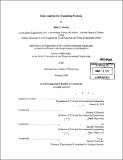| dc.contributor.advisor | Herbert H. Einstein and Daniele Veneziano. | en_US |
| dc.contributor.author | Sousa. Rita L | en_US |
| dc.contributor.other | Massachusetts Institute of Technology. Dept. of Civil and Environmental Engineering. | en_US |
| dc.date.accessioned | 2010-09-02T17:21:51Z | |
| dc.date.available | 2010-09-02T17:21:51Z | |
| dc.date.copyright | 2010 | en_US |
| dc.date.issued | 2010 | en_US |
| dc.identifier.uri | http://hdl.handle.net/1721.1/58282 | |
| dc.description | Thesis (Ph. D.)--Massachusetts Institute of Technology, Dept. of Civil and Environmental Engineering, 2010. | en_US |
| dc.description | Cataloged from PDF version of thesis. | en_US |
| dc.description | Includes bibliographical references (p. 574-589). | en_US |
| dc.description.abstract | Tunnel construction is increasing world wide. Although the majority of tunnel construction projects have been completed safely, there have been several incidents that have resulted in delays, cost overruns, and sometimes more significant consequences such as injury and loss of life. To help eliminate these accidents, it is necessary to systematically assess and manage the risks associated with tunnel construction. In order to better understand the conditions under which accidents occur, a database of 204 tunnel construction accidents was assembled. This is the most comprehensive database known to date. The database was analyzed to better understand the causes of accidents. Influence diagrams were constructed containing the main factors, and the interactions between them. These served as the basis of the risk assessment methodology presented in this work. The risk assessment methodology consists of combining a geologic prediction model that allows one to predict geology ahead of the tunnel construction, with a decision support model that allows one to choose amongst different construction strategies the one that leads to minimum risk. The geologic prediction model is based on Bayesian networks because of their ability to combine domain knowledge with data, encode dependencies among variables, and their ability to learn causal relationships. | en_US |
| dc.description.abstract | (cont.) The combined geologic prediction - decision support model was then applied to the Porto Metro, in Portugal. The results of the geologic prediction model were in good agreement with the observed geology, and the results of the decision support model were in good agreement with the construction methods used. More significant, however, is the ability of the model to predict changes in geology and consequently changes in construction strategy. This was shown in two zones of the tunnel were accidents occurred, where the model predicted an abrupt change in geology, and the construction method should have been changed but was not. Using the model could have possibly avoiding the accidents. This risk assessment methodology provides a powerful tool with which planners and engineers can systematically assess and mitigate the inherent risks associated with tunnel construction. | en_US |
| dc.description.statementofresponsibility | by Rita L. Sousa. | en_US |
| dc.format.extent | 589 p. | en_US |
| dc.language.iso | eng | en_US |
| dc.publisher | Massachusetts Institute of Technology | en_US |
| dc.rights | M.I.T. theses are protected by
copyright. They may be viewed from this source for any purpose, but
reproduction or distribution in any format is prohibited without written
permission. See provided URL for inquiries about permission. | en_US |
| dc.rights.uri | http://dspace.mit.edu/handle/1721.1/7582 | en_US |
| dc.subject | Civil and Environmental Engineering. | en_US |
| dc.title | Risk analysis for tunneling projects | en_US |
| dc.type | Thesis | en_US |
| dc.description.degree | Ph.D. | en_US |
| dc.contributor.department | Massachusetts Institute of Technology. Department of Civil and Environmental Engineering | |
| dc.identifier.oclc | 639544869 | en_US |
